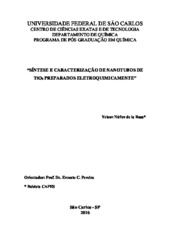Síntese e caracterização de nanotubos de TiO2 preparados eletroquimicamente
Resumen
In the field of nanotechnology, the titanium dioxide (TiO2) has been widely studied for its optical and electrical properties. This oxide is an n-Type semiconductor and is found naturally in
different crystalline phases. Recently, this material has attracted much attention as photocatalyst for the electrochemical photolysis of water displaying a high efficiency, chemical stability and a large surface area. Furthermore, for this application has been proposed that the synthesis of TiO2 nanotubes (Nts-TiO2)
prepared by anodization are promising. Thus, we aimed to study the correlation between the synthesis - morphological and microstructural properties for the optical properties of Nts-TiO2 prepared electrochemically, using the
photoelectrochemical decomposition reaction of water as a reaction target optical properties. For this, the Nts-TiO2 were prepared by anodizing the titanium substrate in Ethylene glycol solutions /water/ ionic liquid (BMIM-BF4), followed
by a heat treatment at 450 °C. In this study, we performed a factorial design 23 to: i) evaluate the statistical significance of synthesis variables: applied potential (Eapl), bath temperature (Tbanho) and percentage of water in the electrolyte (%A); and ii) quantify the correlation between synthesis, morphological, microstructural and optical properties of Nts-TiO2. The synthesized nanotubes were characterized by their morphology and photoelectrochemical properties. The characterization by X-ray diffraction indicated characteristic peaks only the anatase phase interest. The band gap determined by the Wood-Tauc method were calculated values near
3.2 eV. The scanning electron micrographs showed the formation of Nts-TiO2 in all conditions of synthesis, with an internal diameter with values between 23 and 65 nm, being statistically significant main effects Tbanho and %A and interactions effects of Eapl -%A. To study the photoelectrochemical properties of the
electrodes, linear voltammetry experiments were carried out in the light and dark in 0, 5 M H2SO4 solution, the photocurrent density values obtained in the course showed values up to 300 μA cm-2 at 1.01 V vs Ag/AgCl/KClsat. (Water oxidation
potential for the system studied) compared with the response obtained in the dark. With the results obtained, is observed the variability in current density in function of morphological, microstructural and semiconducting properties of Nts-TiO2. Key words: Titanium dioxide, photoelectrochemical cell, TiO2
